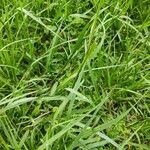Rhizomatous perennial forming dense sods; culms 15-50 cm. high, flattened, glabrous; leaves crowded toward the base, the lower sheaths short, overlapping, those of the culm few, elongate; sheaths keeled, compressed, glabrous or sometimes pubescent, the margins often ciliate toward the summit; ligule very short, mem-branaceous; blades 2-30 cm. long, 3-10 mm. wide, glabrous, the margins ciliate at least toward the base; racemes 2 or rarely 3, 2.5-12 cm. long, subconjugate, ascending, more or less arcuate, the rachis about 1 mm. wide; spikelets 2.5-3.8 mm. long, solitary, ovate or obovate, the glume and sterile lemma equal, firm, smooth and shining; fruit 2.5-3.5 mm. long, oval.
Tufted perennial 100-600 mm high, often decumbent; long stout rhizomes are well developed and horizontally creeping, almost woody, clad in overlapping leaf sheaths; culm nodes glabrous. Leaf blade 60-240 x 4-10 mm; ligule 2-6 mm long, conspicuous. Inflorescence of 2 occasionally 3 racemes, 25-130 mm long; rachis often zig-zag; spikelets arranged in two rows, secund. Spikelet 2.8-3.7 x 2.0-2.8 mm, more than 1.5 x longer than wide, green, glabrous, glossy, apex rounded; lower glume absent; upper glume and lower lemma as long as spikelet; upper lemma finely striate, pallid at maturity, 5-nerved; anther 1.6-1.8 mm long.
Mat forming perennial arising from stout rhizomes; culms 15–50 cm. high.. Leaf-blades broadly linear, 2–30 cm. long, 3–10 mm. wide, stiffly spreading.. Inflorescence composed of 2 (rarely 3) racemes barely separated by a common axis ± 5 mm. long; racemes 2.5–12 cm. long, bearing the spikelets singly in 2 rows on a narrow rhachis ± 1 mm. wide.. Spikelets broadly elliptic, 2.5–3.8 mm. long, green; upper glume and lower lemma as long as the spikelet, cartilaginous, glabrous; upper lemma finely striate, pallid at maturity.
Perennial, long rhizomatous and tufted (often decumbent), up to up to 0.6 m high. Rhizome well developed, almost woody, clad in overlapping leaf sheaths. Leaf blades 60-240 mm long, 4-10 mm wide. Spikelets 2.8-3.7 mm long, 2.0-2.8 mm wide. Racemes 2 (occasionally 3), 25-130 mm long; rhachis often zigzag; spikelets glabrous, glossy, tips rounded, more than 1.5 times longer than wide and arranged in 2 rows.
Perennial; up to 0.6 m high; long rhizome well developed; almost woody; clad in overlapping leaf sheaths; horizontally creeping; tufted. Culms decumbent. Leaf blades 60-240 x 4-10 mm. Flowers: inflorescence digitate; racemes 2(3); 25-130 mm long; rachis often zigzag; spikelets 2.8-3.7 x 2.0-2.8 mm; glabrous; glossy; apices rounded; arranged in 2 rows.
Racemes paired (rarely 3), each 2.5–12 cm. long, the spikelets borne singly in 2 rows on a narrow rhachis.
Inferior lemma cartilaginous, glabrous. Superior lemma pallid at maturity.
Spikelets 2.5–3.8 mm. long, broadly elliptic, plumply plano-convex, green.
Mat-forming perennial arising from stout rhizomes.
Superior glume cartilaginous, glabrous.
Culms 15–50 cm. high.




